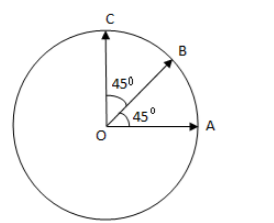
Find the resultant of three vectors $\overrightarrow{OA}$, $\overrightarrow{OB}$ and $\overrightarrow{OC}$ shown in the figure given below. Radius of the circle is $R$.


Answer
504.9k+ views
Hint:Vectors cannot be added simply as scalars are added because they have magnitude as well as direction. All the three vectors are in different directions. We will find their components in $X$ direction and in $Y$ direction.
Complete step by step answer:
Vector is a quantity which has both magnitude and direction. It is represented by an arrow whose direction is the same as that of the quantity and whose length is proportional to the quantity’s magnitude. A vector is not altered if it is displaced parallel to itself.
To add the given three vectors we will find their components in X direction and in Y direction.Let us take the direction of $\overrightarrow{OA}$ as X axis and perpendicular to this, which is the direction of $\overrightarrow{OC}$ as Y axis. Therefore, $\overrightarrow{OA}$ The vector is in X direction only and has no component in Y direction.$\overrightarrow{OC}$ has its component only in the Y direction.
Vector $\overrightarrow{OB}$ is making ${{45}^{\circ }}$angle with the X axis as well as with the Y axis.
$\left| \overrightarrow{OA} \right|=\left| \overrightarrow{OB} \right|=\left| \overrightarrow{OC} \right|=R$ (given)
$X$ components:-
Sum of vectors in $x$ direction=${{v}_{x}}$
${{v}_{x}}$= $R\cos 0+R\cos 45+R\cos 90$
$\Rightarrow {{v}_{x}}=R+\frac{R}{\sqrt{2}}+0$
$\Rightarrow {{v}_{x}}=R\left( 1+\frac{1}{\sqrt{2}} \right)$
Sum of $y$ Components=
${{v}_{x}}=R\sin 90+R\sin 45+R\sin 0 \\
\Rightarrow {{v}_{x}}=R+\frac{R}{\sqrt{2}}+0 \\
\Rightarrow {{v}_{x}}=R\left( 1+\frac{1}{\sqrt{2}} \right) \\ $
$\Rightarrow \text{Resultant vector} =\sqrt{v_{x}^{2}+v_{y}^{2}}$
$\Rightarrow \text{Resultant}= \sqrt{{{\left[ R\left( 1+\frac{1}{\sqrt{2}} \right) \right]}^{2}}+{{\left[ R\left( 1+\frac{1}{\sqrt{2}} \right) \right]}^{2}}}$
$\Rightarrow \text{Resultant} =R\sqrt{2{{\left( 1+\frac{1}{\sqrt{2}} \right)}^{2}}}$
$\therefore \text{Resultant}=R\left( \sqrt{2}+1 \right)$
Hence, the resultant of three vectors is $R\left( 1+\sqrt{2} \right)$.
Note:We can use the parallelogram law of vector addition first for two vectors and then using their resultant vector with the third vector to calculate the resultant of three vectors. Do not add the vectors simply and do not forget to find their components to get the resultant vector.
Complete step by step answer:
Vector is a quantity which has both magnitude and direction. It is represented by an arrow whose direction is the same as that of the quantity and whose length is proportional to the quantity’s magnitude. A vector is not altered if it is displaced parallel to itself.
To add the given three vectors we will find their components in X direction and in Y direction.Let us take the direction of $\overrightarrow{OA}$ as X axis and perpendicular to this, which is the direction of $\overrightarrow{OC}$ as Y axis. Therefore, $\overrightarrow{OA}$ The vector is in X direction only and has no component in Y direction.$\overrightarrow{OC}$ has its component only in the Y direction.
Vector $\overrightarrow{OB}$ is making ${{45}^{\circ }}$angle with the X axis as well as with the Y axis.
$\left| \overrightarrow{OA} \right|=\left| \overrightarrow{OB} \right|=\left| \overrightarrow{OC} \right|=R$ (given)
$X$ components:-
Sum of vectors in $x$ direction=${{v}_{x}}$
${{v}_{x}}$= $R\cos 0+R\cos 45+R\cos 90$
$\Rightarrow {{v}_{x}}=R+\frac{R}{\sqrt{2}}+0$
$\Rightarrow {{v}_{x}}=R\left( 1+\frac{1}{\sqrt{2}} \right)$
Sum of $y$ Components=
${{v}_{x}}=R\sin 90+R\sin 45+R\sin 0 \\
\Rightarrow {{v}_{x}}=R+\frac{R}{\sqrt{2}}+0 \\
\Rightarrow {{v}_{x}}=R\left( 1+\frac{1}{\sqrt{2}} \right) \\ $
$\Rightarrow \text{Resultant vector} =\sqrt{v_{x}^{2}+v_{y}^{2}}$
$\Rightarrow \text{Resultant}= \sqrt{{{\left[ R\left( 1+\frac{1}{\sqrt{2}} \right) \right]}^{2}}+{{\left[ R\left( 1+\frac{1}{\sqrt{2}} \right) \right]}^{2}}}$
$\Rightarrow \text{Resultant} =R\sqrt{2{{\left( 1+\frac{1}{\sqrt{2}} \right)}^{2}}}$
$\therefore \text{Resultant}=R\left( \sqrt{2}+1 \right)$
Hence, the resultant of three vectors is $R\left( 1+\sqrt{2} \right)$.
Note:We can use the parallelogram law of vector addition first for two vectors and then using their resultant vector with the third vector to calculate the resultant of three vectors. Do not add the vectors simply and do not forget to find their components to get the resultant vector.
Recently Updated Pages
Why are manures considered better than fertilizers class 11 biology CBSE

Find the coordinates of the midpoint of the line segment class 11 maths CBSE

Distinguish between static friction limiting friction class 11 physics CBSE

The Chairman of the constituent Assembly was A Jawaharlal class 11 social science CBSE

The first National Commission on Labour NCL submitted class 11 social science CBSE

Number of all subshell of n + l 7 is A 4 B 5 C 6 D class 11 chemistry CBSE

Trending doubts
What is meant by exothermic and endothermic reactions class 11 chemistry CBSE

10 examples of friction in our daily life

One Metric ton is equal to kg A 10000 B 1000 C 100 class 11 physics CBSE

1 Quintal is equal to a 110 kg b 10 kg c 100kg d 1000 class 11 physics CBSE

Difference Between Prokaryotic Cells and Eukaryotic Cells

What are Quantum numbers Explain the quantum number class 11 chemistry CBSE




